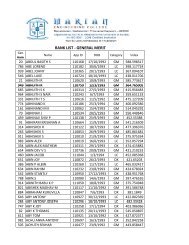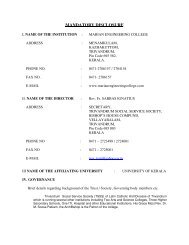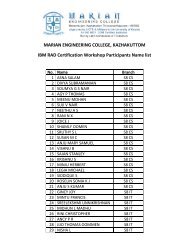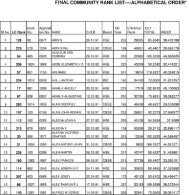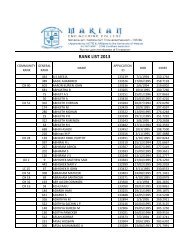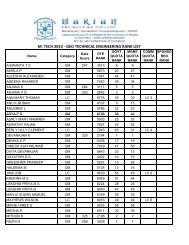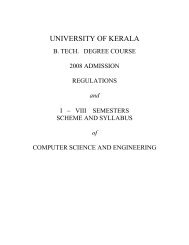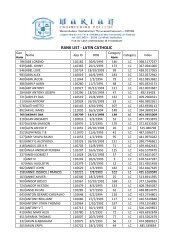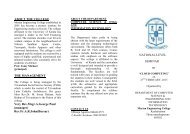UNIVERSITY OF KERALA - College of Engineering, Trivandrum
UNIVERSITY OF KERALA - College of Engineering, Trivandrum
UNIVERSITY OF KERALA - College of Engineering, Trivandrum
You also want an ePaper? Increase the reach of your titles
YUMPU automatically turns print PDFs into web optimized ePapers that Google loves.
08.109 BASIC COMMUNICATION AND INFORMATION<br />
ENGINEERING<br />
L – T – P: 2-1-0 Credits: 6<br />
MODULE 1(Qualitative Treatment)<br />
(a) Bipolar junction transistors: NPN & PNP transistors, structure, typical doping, working <strong>of</strong> NPN transistor,<br />
concepts <strong>of</strong> common base, common emitter & common collector configurations, current gain <strong>of</strong> each, input &<br />
output characteristics <strong>of</strong> common emitter configuration, comparison <strong>of</strong> three configurations with reference to<br />
voltage & current gain, input & output resistances and applications. (6 hrs)<br />
(b) Field effect Transistors : basic principles <strong>of</strong> JFET, MESFET and MOSFET, comparison with BJT. (3 hrs)<br />
(c) Amplifiers & Oscillators: circuit diagram & working <strong>of</strong> common emitter amplifier, function <strong>of</strong> each<br />
component in the circuit, need <strong>of</strong> proper biasing, frequency response, voltage gain and 3dB bandwidth, concepts<br />
<strong>of</strong> class A, B, AB and Class C power amplifiers, circuit diagram & working <strong>of</strong> push pull amplifiers, concepts<br />
<strong>of</strong> feedback, working principles <strong>of</strong> oscillators, circuit diagram & working <strong>of</strong> RC phase shift oscillator (7 hrs)<br />
(d) Integrated circuits: advantages <strong>of</strong> ICs, analog and digital ICs, functional block diagram <strong>of</strong> operational<br />
amplifier, ideal operational amplifier, use as inverting amplifier, non inverting amplifier, summing amplifier,<br />
integrator and comparator. (4 hrs)<br />
(e) Digital ICs: logic gates, realization <strong>of</strong> logic functions, principle <strong>of</strong> combinational and sequential logic<br />
circuits, flip flop (JK), logic families: TTL and CMOS Logic (No internal diagram) (4 hrs)<br />
(f) IC fabrication: purification <strong>of</strong> silicon, crystal growth, wafer preparation. unit process: oxidation, diffusion,<br />
ion implantation, epitaxy, deposition, photolithography. (4 hrs)<br />
MODULE 2 (Qualitative Treatment)<br />
(a) Measurements: principle and block diagram <strong>of</strong> analog and digital multimeter, working principle <strong>of</strong> CRT,<br />
block diagram <strong>of</strong> CRO, measurements using CRO, principle <strong>of</strong> digital storage oscilloscope, principle and block<br />
diagram <strong>of</strong> function generator. (5hrs)<br />
(b) Radio communication: principle <strong>of</strong> AM & FM, wave forms, bandwidths, block diagrams <strong>of</strong> AM & FM<br />
transmitters, principle <strong>of</strong> AM &FM demodulation, comparison <strong>of</strong> AM & FM, principle &block diagram <strong>of</strong><br />
super heterodyne receiver. (4 hrs)<br />
(c) Color television: TV Standards, interlaced scanning, block diagram <strong>of</strong> PAL TV transmitter & receiver,<br />
basic principles <strong>of</strong> cable TV, CCTV system, basic principles <strong>of</strong> HDTV, basic principles <strong>of</strong> LCD & Plasma<br />
displays. (5 hrs)<br />
(d) Radar and navigation: principle <strong>of</strong> radar and radar equation, block schematics <strong>of</strong> pulsed radar, factors<br />
affecting range, applications <strong>of</strong> radar in measurements and navigation. (4 hrs)<br />
(e) Satellite communication: microwave frequency bands, concept <strong>of</strong> geo-stationary satellite, frequency bands<br />
used, satellite transponder, block diagram <strong>of</strong> earth station transmitter & receiver, advantages <strong>of</strong> satellite<br />
communication, principle <strong>of</strong> Global Positioning System(GPS). (3 hrs)<br />
(f) Optical communication: block diagram <strong>of</strong> the optical communication system, principle <strong>of</strong> light<br />
transmission through fiber, concepts <strong>of</strong> Single Mode and Multi Mode optical fiber, working principle <strong>of</strong> source<br />
(semiconductor Laser) & detector ( PIN,APD), advantages <strong>of</strong> optical communication. (5 hrs)<br />
MODULE 3 (Qualitative Treatment)<br />
(a) Computer Architecture: functional units: basic concept <strong>of</strong> ALU- data path and control, memory<br />
hierarchy, caches, main memory, virtual memory, operating systems, microprocessors - functional block<br />
diagram <strong>of</strong> 8085 (9 hrs)<br />
(b) Data communication: overview, analog and digital data transmission, transmission media, digitization <strong>of</strong><br />
wave forms, PCM , digital modulation techniques- ASK, PSK, FSK, basic concepts <strong>of</strong> error detection , parity<br />
checking. (6hrs)<br />
(c) Mobile communication: basic principles <strong>of</strong> cellular communications, concepts <strong>of</strong> cells, frequency reuse,<br />
principle and block diagram <strong>of</strong> GSM,principle <strong>of</strong> CDMA, WLL & GPRS technologies. (4hrs)<br />
(d) Internet Technology: concepts <strong>of</strong> networking: client - server computing, IP addresses, domain names,<br />
network interface unit - modem, switching technologies- circuit switching and packet switching,<br />
25



